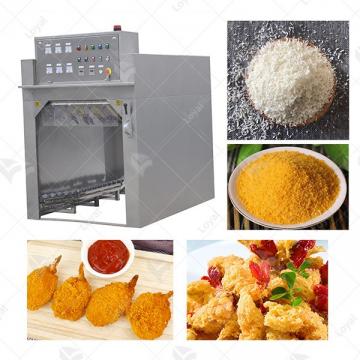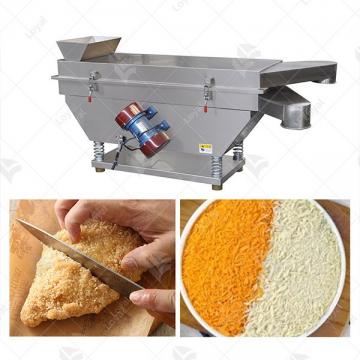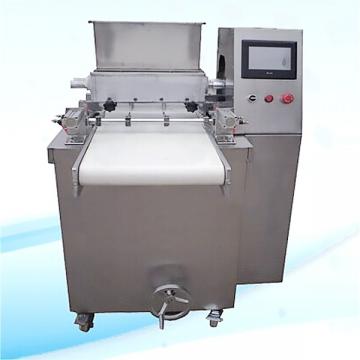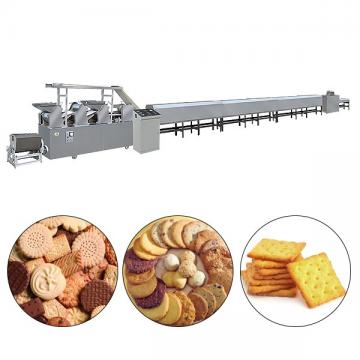
- Shandong Loyal Industrial Co.,Ltd.
- Macaroni Production Machine Instant Noodle Machine Biscuit Making Machine
Home> Processing> Unlock The Secrets Of Efficient Biscuit Production Line Manufacturing

Unlock The Secrets Of Efficient Biscuit Production Line Manufacturing
2025-06-24 17:14:17If you want to know more story about LOYAL brand, here can help you - https://www.facebook.com/foodmachineloyal
Introduction:Sustainable Design Approaches for Biscuit Production Lines
The global biscuit industry faces increasing pressure to adopt sustainable practices while maintaining production efficiency and product quality. Biscuit production lines, which encompass mixing, forming, baking, cooling, and packaging stages, are typically energy-intensive, with baking alone accounting for up to 40% of total energy consumption. As consumer demand grows for both soft and hard biscuit varieties, manufacturers must balance high output with environmental responsibility.
Traditional biscuit making machines often rely on fossil fuel-powered ovens and inefficient heat distribution systems, leading to excessive energy waste. Additionally, variations in dough composition—such as higher moisture content in soft biscuit production or denser formulations for hard biscuit varieties—further complicate energy optimization. These challenges highlight the need for innovative, sustainable design approaches that reduce carbon emissions without compromising production speed or product consistency.
This article explores cutting-edge strategies to enhance energy efficiency in biscuit production lines, from advanced baking technologies to smart automation and renewable energy integration. By analyzing industry trends and successful case studies, we aim to provide actionable insights for manufacturers seeking to modernize their biscuit making machines while meeting sustainability goals for both soft and hard biscuit products.
Energy Consumption Analysis in Biscuit Production
Process flow: Flour Mixer→Shaping&Cutting→Controller→Baking Oven→Spraying Oil→Cooling→Packing
The biscuit production line is a complex system where energy usage varies significantly across different stages of manufacturing. Understanding these consumption patterns is critical for implementing sustainable improvements, particularly when producing both soft and hard biscuit varieties, which have distinct processing requirements.
1. Key Energy-Intensive Stages
Mixing & Dough Preparation
High-power motors in biscuit making machines operate continuously, with energy demand influenced by dough type (e.g., higher hydration for soft biscuit vs. dense mixes for hard biscuit).
Inefficient mixing can lead to over-processing, wasting electricity.
Baking – The Largest Energy Consumer
Conventional ovens in biscuit production lines account for 40–60% of total energy use.
Soft biscuit baking requires precise humidity and temperature control, while hard biscuit production often demands higher temperatures and longer baking times.
Heat loss through poor insulation or exhaust systems further reduces efficiency.
Cooling & Packaging
Cooling tunnels consume substantial energy to stabilize products before packaging.
Hard biscuits may require longer cooling periods than soft varieties, increasing energy use.
2Challenges in Soft vs. Hard Biscuit Production
Soft Biscuits: Require gentle baking to retain moisture, increasing energy use for humidity control.
Hard Biscuits: Need prolonged high-temperature baking, raising fuel consumption.
Solution: Adaptive biscuit making machines with zone-specific temperature settings can reduce waste.

Sustainable Design Strategies for Biscuit Manufacturing
As the demand for both soft and hard biscuit products continues to rise, manufacturers must adopt innovative approaches to reduce energy consumption while maintaining high-quality output. Modern biscuit production lines can achieve significant efficiency improvements through sustainable design, smart technology integration, and renewable energy adoption. Below are key strategies to optimize biscuit making machines for eco-friendly production.
1. Energy-Efficient Baking Technologies
The baking stage remains the most energy-intensive phase in biscuit production lines. Innovations in oven design can drastically cut energy waste:
Hybrid Heating Systems – Combining electric and gas heating allows better control over temperature zones, particularly useful when switching between soft and hard biscuit recipes.
Infrared & Microwave-Assisted Baking – These technologies reduce baking time by up to 25% while ensuring uniform heat distribution.
Heat Recovery Systems – Capturing waste heat from ovens and redirecting it to preheat dough or dry ingredients improves overall efficiency.
2. Smart Automation & Process Optimization
Integrating AI and IoT into biscuit making machines enables real-time adjustments for minimal energy waste:
Adaptive Dough Handling – Sensors detect dough consistency (critical for differentiating soft biscuit high-moisture dough from hard biscuit firmer mixes) and adjust machine settings automatically.
Predictive Maintenance – AI algorithms monitor equipment health, preventing unexpected downtime that disrupts energy-efficient cycles.
Dynamic Oven Control – Machine learning optimizes temperature and conveyor speed based on biscuit type, reducing overbaking and energy spikes.
3. Renewable Energy Integration
Transitioning to clean energy sources is a long-term solution for sustainable biscuit production lines:
Solar Thermal Systems – Solar-powered preheaters can supplement traditional ovens, especially in sun-rich regions.
Biomass & Waste-to-Energy – Some factories use agricultural byproducts (e.g., husks, spent grains) to fuel baking processes.
Energy Storage Solutions – Battery systems store excess renewable energy for use during peak production hours.

Material & Waste Reduction Techniques in Biscuit Manufacturing
Sustainable biscuit production lines must address not only energy efficiency but also material optimization and waste management. Both soft and hard biscuit manufacturing generate significant byproducts, from dough scraps to packaging waste. Implementing circular economy principles in biscuit making machines and processes can dramatically reduce environmental impact while cutting costs.
1. Eco-Friendly Packaging Solutions
Biodegradable & Recyclable Materials
Transitioning from plastic to compostable wrappers for soft biscuit products, which often require moisture-resistant packaging.
Using mono-material films for hard biscuit packs to improve recyclability.
Lightweight Packaging Designs
Reducing material thickness without compromising product protection, lowering transportation emissions.
Smart packaging with moisture control for soft biscuit varieties to extend shelf life naturally.
2. Dough Recycling & Byproduct Utilization
Closed-Loop Dough Handling
Biscuit making machines equipped with scrap dough collectors that reintegrate excess into new batches (requires formulation adjustments for hard biscuit doughs).
Advanced sensors to segregate uncontaminated dough scraps automatically.
Value-Added Byproduct Applications
Turning bran and broken biscuits into ingredients for cereal bars or pet food.
Fermenting dough waste for bioethanol production in some facilities.
3. Water & Raw Material Conservation
Precision Ingredient Dispensing
Automated measuring systems in modern biscuit production lines reduce flour/sugar overuse by 5-8%.
Differentiated hydration systems for soft biscuit (higher water needs) vs. hard biscuit mixes.
Water Recycling Systems
Capturing and filtering water from cleaning processes for reuse in non-product contact areas.
Dry cleaning methods for certain biscuit making machines to minimize water consumption.
Case Studies & Industry Trends in Sustainable Biscuit Manufacturing
The global biscuit industry is undergoing a green transformation, with leading manufacturers demonstrating how innovation can drive sustainability without compromising productivity. This section examines real-world implementations of energy-efficient biscuit production lines, emerging technologies in biscuit making machines, and shifting consumer preferences for both soft and hard biscuit products.
1. Successful Implementations of Sustainable Biscuit Production Lines
Nestlé's Net Zero Ambitions (UK)
Installed electric ovens powered by 100% renewable energy in their biscuit production lines, reducing CO₂ emissions by 2,500 tons annually.
Implemented AI-driven quality control that adapts baking parameters between soft biscuit (e.g., KitKat) and hard biscuit (e.g., digestive) varieties.
Mondelez International's Smart Factory (Germany)
Integrated heat recovery systems that reuse 80% of waste heat from biscuit making machines for facility heating.
Developed hybrid production lines capable of switching between soft and hard biscuit recipes with minimal energy penalty.
2. Technological Innovations in Biscuit Making Machines
Modular Machine Designs
Plug-and-play components allow rapid reconfiguration for different product types (e.g., adjusting extruder dies for soft biscuit vs. rotary molding for hard biscuit).
Reduces changeover energy waste by up to 40%.
Hydrogen-Powered Baking Trials
Pilot projects in Scandinavia testing hydrogen-fueled ovens that emit only water vapor.
Early results show comparable quality for hard biscuit products with 100% fossil-free operation.
IoT-Enabled Predictive Maintenance
Vibration sensors and thermal imaging on biscuit production lines prevent unexpected downtime.
Particularly crucial for soft biscuit lines where temperature fluctuations affect product texture.
3. Consumer-Driven Market Shifts
Premiumization of Sustainable Products
68% of consumers willing to pay more for biscuits made in eco-friendly facilities (2024 Mintel data).
Brands highlighting solar-baked hard biscuit or sustainably packaged soft biscuit varieties.
Regulatory Pressures
EU's Corporate Sustainability Reporting Directive (CSRD) forcing transparency in biscuit production line energy use.
Tax incentives for manufacturers using renewable energy in biscuit making machines.

Challenges & Future Outlook for Sustainable Biscuit Production
The transition to energy-efficient biscuit production lines presents both technical hurdles and exciting opportunities. As manufacturers strive to balance sustainability with profitability—while meeting diverse requirements for soft and hard biscuit production—several key challenges and emerging solutions are shaping the industry's future.
1. Economic & Technical Barriers
High Capital Costs
Retrofitting traditional biscuit making machines with energy-saving features (e.g., heat recovery systems) requires significant investment, with payback periods of 3–5 years.
Small-scale producers face particular challenges in upgrading biscuit production lines for soft biscuit niche markets.
Recipe Adaptation Complexities
Sustainable baking technologies (e.g., infrared) may require reformulation of hard biscuit recipes to maintain texture and shelf life.
Soft biscuit varieties are more sensitive to changes in oven humidity controls during energy-saving modes.
Supply Chain Dependencies
Renewable energy availability varies regionally, affecting the feasibility of solar/wind-powered biscuit production lines.
Sustainable packaging materials (e.g., compostable films) often lack the moisture barrier properties needed for soft biscuit preservation.
2. Emerging Solutions & Future Technologies
Next-Gen Biscuit Making Machines
Development of "dual-mode" ovens that automatically optimize energy use for alternating soft and hard biscuit production runs.
3D food printing trials for customized biscuit shapes with 30% less material waste.
Circular Economy Integration
Closed-loop water systems that recycle 95% of processing water in biscuit production lines.
Partnerships with breweries to repurpose spent grains as ingredients for fiber-rich hard biscuit products.
Policy & Certification Drivers
Anticipated ISO standards for sustainable biscuit manufacturing (projected 2026).
Blockchain systems to trace renewable energy usage in biscuit making machines for carbon credit verification.
3. The Road Ahead: 2030 Projections
Energy
60% of industrial biscuit production lines expected to use hybrid renewable energy.
Efficiency
AI-optimized biscuit making machines to reduce energy waste by 40–50% for both soft and hard biscuit types.
Waste
Industry-wide target of zero dough waste through advanced recycling biscuit production lines.

Small biscuit process line technical parameter:
|
Item No. |
Capacity(kg/h) |
Heating type |
|
LY-25-I |
40-50kg/h |
Electricity,Gas,Diesel |
|
LY-25-II |
50-100kg/h |
Electricity,Gas,Diesel |
|
LY-320 |
100-150kg/h |
Electricity,Gas,Diesel |
Automatic biscuit process line technical parameter:
|
Item No. |
Capacity(kg/h) |
Heating type |
|
LY-400 |
150-200kg/h |
Electricity,Gas,Diesel |
|
LY-600 |
400-500kg/h |
Electricity,Gas,Diesel |
|
LY-800 |
600-800kg/h |
Electricity,Gas,Diesel |
|
LY-1000 |
1000kg/h |
Electricity,Gas,Diesel |
|
LY-1200 |
2000kg/h |
Electricity,Gas,Diesel |
Conclusion: The Path Forward for Sustainable Biscuit Manufacturing
The biscuit industry stands at a critical juncture where sustainability and efficiency must converge to meet both environmental targets and consumer demands. Through innovative redesign of biscuit production lines and advanced biscuit making machines, manufacturers can significantly reduce energy consumption while maintaining the quality of both soft and hard biscuit varieties.
Key Takeaways
Energy Efficiency as Standard Practice
Modern ovens with heat recovery and smart automation should become baseline features in biscuit production lines, adaptable for both soft biscuit (precise humidity control) and hard biscuit (high-temperature) requirements.
Holistic Sustainability Approach
Beyond energy, successful strategies must encompass waste reduction (dough recycling), water conservation, and eco-friendly packaging - particularly moisture-sensitive solutions for soft biscuit products.
Technology-Driven Transformation
AI optimization in biscuit making machines and renewable energy integration are no longer futuristic concepts but present-day necessities for competitive, sustainable production.
Collaborative Industry Evolution
Addressing capital investment barriers requires shared R&D efforts and policy support, especially for small manufacturers producing specialty hard biscuit or artisanal soft biscuit products.
For manufacturers, the choice is clear: embracing automation and AI in biscuit production machines isn't optional—it's essential for staying competitive. For consumers, it means consistently perfect biscuits, with more variety and lower environmental impact.
As we've seen across every section—from smart sensors to self-learning ovens—the future of biscuit manufacturing is already here. And one thing's certain: this is just the beginning. The biscuit process line of tomorrow will continue to surprise us, innovate for us, and yes—delight our taste buds in ways we can't yet imagine.

Reference
The following are five authoritative foreign literature websites in the field of Industrial food machinery:
1. Food Engineering Magazine
Website: https://www.foodengineeringmag.com/
2.Food Processing Magazine
Website: https://www.foodprocessing.com/
3.Journal of Food Engineering
Website:https://www.journals.elsevier.com/journal-of-food-engineering
4. Food Manufacturing Magazine
Website:https://www.foodmanufacturing.com/
5. International Journal of Food Science & Technology
Website:https://onlinelibrary.wiley.com/
 Commercial Japanese Panko Bread Crumb Grinder Machine
Commercial Japanese Panko Bread Crumb Grinder Machine Japanese Bread Crumbs Processing Line
Japanese Bread Crumbs Processing Line Automatic Cookies Making Machines
Automatic Cookies Making Machines Fully Automatic Biscuit Making Machines
Fully Automatic Biscuit Making Machines